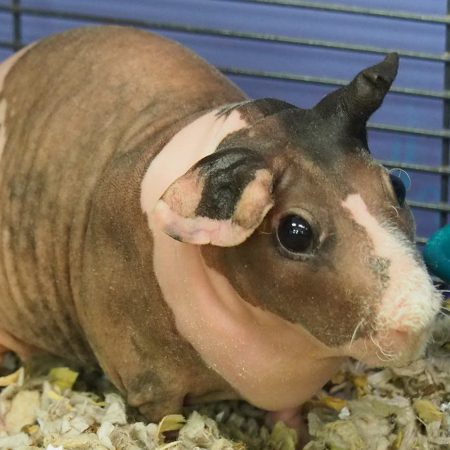Skinny Pig
Cavia porcellus
The Skinny Pig is a breed of almost hairless Guinea pig. They do have a little bit of hair on their muzzles, feet, and legs but the remainder of their bodies is virtually hairless. Some may have a thin covering of fuzzy hair on their backs. Their skin is smooth to the touch, with some wrinkling around the legs and neck. Skinny pigs can come in a variety of colours and patterns. They’ve gotten the name “skinny” to describe the illusion of their visually thinner appearance, or colloquially reggering to the exposed skin of the animal.
The modern Skinny Pig breed originated with a cross between haired guinea pigs and a hairless lab strain. The hairless strain was a spontaneous genetic mutation first identified and recorded at Montreal’s Armand Frappier Institute in 1978. Skinny pigs are commonly used in dermatology studies today. The physiology of a skinny pig isn’t much different than that of a regular haired guinea pig, although they do need to eat more to maintain body heat. The optimal temperature range for a hairless guinea pig is 75 to 80 degrees Fahrenheit. Skinny pigs must be given special attention to their sensitive skin, they are vulnerable to sunburn, dry skin, and other injuries.

Modern Skinny Pigs originated from a cross between regular haired guinea pigs and a hairless lab strain first observed in Quebec.
HABITAT -Skinny Pigs are a form of domesticated guinea pigs that live in home environments with humans.
DIET -Mainly consisting of grass and hay, dry food pellets, fresh fruits and vegetables.
FUN FACT -Skinny pigs need to eat more than their non-hairless counterparts in order to put more energy into generating body heat.
SOCIAL BEHAVIOR -They live together harmoniously, and participate in social grooming with other guinea pigs.
ACTIVITY -They are crepuscular, tending to be most active at dawn and dusk.
PREDATORS -Since skinny pigs do not occur in the wild, they have no natual predators.
SIZE -Typically between 1.5 and 3 lbs, measuring between 8 - 11 in.
RELATIVES -Belonging to the Cavia family, they are related to other rodents like the Patagonian Cavy and regular Guinea Pigs.
CONSERVATION -Skinny Pigs have not been evaluated by the IUCN and are not currently at risk.
Cub Creek Animal Care Information
Housing - Our Skinny Pigs live in specialized enclosures housed in the Small Animal Room. The enclosure provides plenty of space allowing for a variety of hide spaces to make them feel safe and room to explore. Their enclosure is bedded with shavings to make cleanup easy and they always have access to clean water.
Diet - We feed our Skinny Pigs a balanced diet of fruits, vegetables, and small animal pellets to ensure they get all the nutrition they need. We’ll cut up their vegetables (consisting of sweet potatoes and lettuce) and arrange them a veggie platter they love! They also enjoy special treats like timothy hay, dried fruits, and other green vegetables.
Enrichment - Our Skinny Pigs are very sociable animals, they enjoy playing with one another and interacting with campers. During the summertime, campers will make them special toys from cardboard and other materials. They algo get special treats made for them out of fruits and vegetables.

